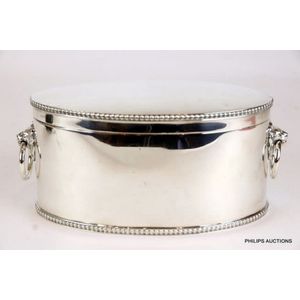1927 Sheffield Sterling Silver Biscuit Box with Lion Handles
An English sterling silver biscuit box, 1927 Sheffield, with W&S maker's mark for Wilson & sharp, the oval sterling silver biscuit or trinket box with applied lion mask ring handles to each side and fine gadroon decoration to both hinged lid and foot, crisply hallmarked to the underside of lid and base. Weight 843g, height 10 cm, length 18.5 cm, width 12 cm
You must be a subscriber, and be logged in to view price and dealer details.
Subscribe Now to view actual auction price for this item
When you subscribe, you have the option of setting the currency in which to display prices to $Au, $US, $NZ or Stg.
This item has been sold, and the description, image and price are for reference purposes only.
- Sterling Silver - Sterling silver is a mixture of 92.5% pure silver and 7.5% of another metal, usually copper. Fine silver is 99.9% pure silver, and is relatively soft and the addition of the very small amount of copper gives the metal enough strength and hardness to be worked into jewellery, decorative and household objects.
- Lion Mask - The lion mask has been used for centuries in various forms of art and design, including furniture, silver, and ceramics, and is usually y depicted as a stylized representation of the face of a lion, often with an open mouth and protruding tongue. and is often used as a handle, knob, or other decorative element.
In furniture design, lion masks were popular in the neoclassical and Empire styles of the late 18th and early 19th centuries. They were often used as decorative elements on the legs or arms of chairs, as well as on cabinet and drawer pulls. It was also used as a handle, knob, or other decorative element.
In silverware design, lion masks were often applied to tea and coffee pots, as well as on candlesticks, snuff boxes, and other small silver items. The lion mask was often used in combination with other neoclassical motifs, such as laurel wreaths or acanthus leaves, to create a sense of grandeur and classical elegance.
In ceramics, lion masks were often depicted in relief, and were sometimes used in combination with other decorative elements, such as garlands or swags.
This item has been included into following indexes:
